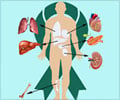Researchers have managed to create clusters of stem cells with the help of 3D printing, paving way for the development of artificial human organs, which can be used in transplants.

The 3D printing technology relies on an adjustable "microvalve", which builds up layers of human embryonic stem cells.
Such cells, which originate from early stage embryos, are blank slates with the potential to become any type of tissue in the body.
In the long term, the new printing technique could pave the way for those cells to be incorporated into transplant-ready laboratory-made organs and tissues, researchers at Heriot-Watt University in Edinburgh said.
The technique's breakthrough is in its gentle handling of the delicate cells which gives them a greater chance to thrive, they said.
Lead scientist Dr Will Shu told Sky News: "We found that the valve-based printing is gentle enough to maintain high stem cell viability".
Advertisement
Taking a cell from a patient and using it in the 3D printing process should enable scientists to implant the generated tissue back into the patient without triggering an immune response.
Advertisement
"However, up to now, human stem cell cultures have been too sensitive to manipulate in this way."
"This is a scientific development which we hope and believe will have immensely valuable long-term implications for reliable, animal-free drug-testing and, in the longer term, to provide organs for transplant on demand, without the need for donation and without the problems of immune suppression and potential organ rejection," he said.
The scientists behind the breakthrough estimate that the 3D printing technology could lead to a "production line" of artificial organs in 10 years' time, at the earliest.
Source-ANI








